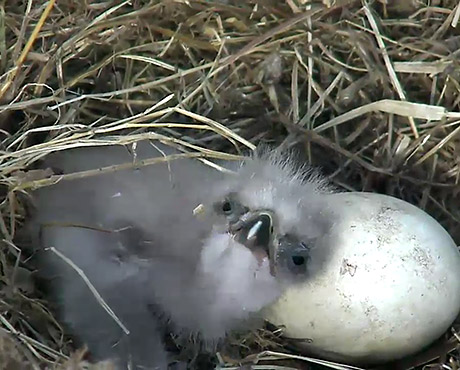[/av_textblock] [av_textblock size=” font_color=” color=” custom_class=”] By Gabe Bullard
March 18, 2016
Crystal Slusher is behind the zooms and pans you see when you watch Bald Eagles nesting and hatching chicks online.
The live camera feed of the nesting Bald Eagles at the National Arboretum in Washington, D.C. has kept birdwatchers glued to their monitors this week as the eagles welcomed their first hatchling of the year.
The new eaglet is hidden from view most of the time, as its mother and father take turns sitting on it to keep it warm. But whenever a parent moves, the camera is quick to respond, panning, zooming, and tilting to give the approximately half million web viewers a better shot of the new baby.
The camera’s controls change hands every few hours, alternating between an employee of National Arboretum and a team of eight volunteers—called “zoomers”—across the United States and Canada. The volunteers are organized by the camera’s host, the American Eagle Foundation of Pigeon Forge, Tennessee. (It’s supported by and located next to Pigeon Forge’s other landmark, Dolly Parton’s Dollywood theme park.)
Crystal Slusher is the foundation’s eagle nest cam education and policy coordinator. She also takes a shift at the controls. We asked her what it was like doing professionally what many of us have been doing for fun in between work tasks—watching the eagles.
“It’s a dream job and one that enriches my life in ways I could never imagine,” she says. “I’m an eagle lover, as are all our volunteer cam operators and chat educators.”
What does running the camera entail?
Paying attention to the movements and behaviors of the adults, watching for anything we think the public may find interesting. And having some basic knowledge about eagle biology. (Read more about America’s majestic national symbol.)
A baby eagle feeds a few hours after hatching. © 2016 American Eagle Foundation, Eagles.org
What do the controls look like?
We are able to control the cams with our mouse from a computer at the office or from our homes. The pan, tilt, and zoom functions use a slider bar on the camera dashboard.
Is someone watching the camera all day?
We have mostly daytime monitoring from our staff of volunteers, however, during exciting time like egg laying, hatching, branching, and fledging, we have 24-hour coverage. [The cameras have an infrared feature to continue catching footage at night.]
How do you decide when to zoom, when to move the camera?
During “hatch watch” we always want to watch the progress of the hatching egg so we try to zoom in on it. The eagle parents roll the eggs quite often, so when they move, we move in quickly with the cameras. [Each nest location has at least two high-definition cams per nest, sometimes three cams.]
While you’re controlling the camera, do you think about the people who are watching?
Yes, we try to think of it as a living picture, and the cam operators are the photographers.
Does it get boring?
I never tire of seeing the interactions of the parents and eaglets.
Click to Watch Live Feed from the DC Eagle Nest Cam.
Your website cautions that “anything can happen” when you’re watching wild animals. What do you do when that happens?
I report what we are seeing to the President of the American Eagle Foundation, Al Cecere, and the Publicity, Marketing, and Social Media Manager, Julia Cecere. We then discuss ways we can help or if help is necessary.
In some instances we have turned it off temporarily until we decided what action we were going to do. In some nests, we’re able to make some adjustments very quickly.
[When asked if they ever do intervene in situations where the course of nature may put an eagle or eaglet in danger, Al Cecere says “we have federal permits for rehabilitating eagles and birds of prey. We have a bit more authority than other folks.”]What’s the most interesting thing you’ve seen on one of the cameras?
The most amazing thing I have seen on our cameras is watching one of our nests hatch three eaglets in less than 24 hours. I have never seen this happen in any other nests I’ve watched. That was the nest of “Independence” and “Franklin” at the AEF’s Dollywood headquarters.
This interview has been condensed and edited.
[/av_textblock]

